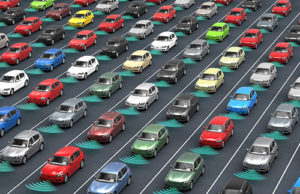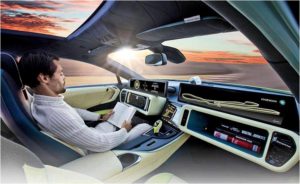Self-driving cars are coming – the ultimate traffic solution for the future, or?
Huge gains to be made with self-driving cars
The self-driving car holds a lot of promises for the future. It will allow a more efficient land use in the cities. Private car ownership could be cut by 50% which would save scarce space in the cities. The self-driving car will be an enabler for mobility as a service. Driving time can become productive time. Or time for online consumption. The potential productivity gains are huge. Autonomous vehicles could potentially eliminate all accidents. So is the autonomous car the solution to all our problems? Before answering that, let me stay with the benefits while elaborating a bit on the use of self-driving vehicles as I see it.
Self-driving, just another fancy feature?
First of all, everything will change. As a Wall Street analyst put it: “It is the end of private car ownership, the internal combustion engine and of car dealerships as we know it. Otherwise it is business as usual”. The autonomous car is a natural extension of a few trends. Such as the declining percentage of youngsters getting driver’s license. The declining car ownership in cities. The strong urbanization trend in combination with the densification of the cities.
Hence, we will not buy a car like we do today, in the future scenario but just adding the self-driving feature. We will not sit at the wheel of our own car with the laptop in front of us, preparing a power point while travelling down the highway at 110 km/h. Our kids staring at the back of the front seats. We will not park our own self-driving car in front of our home. No, as individuals we will be using our mobile device to decide on the most convenient transportation at any given time. May it be a self-driving taxi, walking by foot or any other of the available means of transportation.

How would we use self-driving cars?
A good guess is that self-driving cars will be used as a service. As a last mile transportation or between meetings in the city. The self-driving car will transport itself to the garage when not needed. To your door when you need it. The self-driving capability will be used to bring your rental car to the pick-up area of the airport. There will be autonomous cars transporting goods to your doorstep. This has the potential to reduce traffic and congestion in the city. These applications of the self-driving car will be moving at slow speeds, about 20 km/h. This will ensure safety and be an integral part of what makes the city sustainable.
Finished vehicle logistics – the business case for the automotive industry
The earliest applications of autonomous vehicles will most likely be in finished vehicle logistics. The automotive industry has the potential to save money in reducing manual driving in the vehicle logistics. The vehicle will be able to drive itself through the logistics chain from factory to customer hand-over. The conditions in the finished vehicle logistics are very similar to those of the slow moving city scenario or pick-up applications.
Autonomous cars on the highway?
What about cruising down the highway while taking the eyes off the road to watch movies? This is a question how far do you dare take the autopilot features of the vehicle. The risks in terms of consequences when a crash occurs are much higher than in the slow-moving scenario. We are likely to see more driver assistance features and platooning on highways. It will take time before we fully can rely on the self-driving vehicle. There will be significant differences in usage between private cars and fleet vehicles as well as between city usage and highway usage.

So self-driving cars are the ultimate transportation solution?
Autonomous driving technology has so many benefits and will help transforming our cities towards sustainability. What can possibly go wrong? Test vehicles are now being rolled out around the world to create the first learning experiences. However, we can already now foresee some challenges that need to be overcome. There are legal challenges as well as technical and behavioral challenges.
Legal challenges with self-driving vehicles
The legal challenges occur as we remove the driver. The Geneva Convention on Road Traffic states there should be a driver in all vehicles and the driver shall at all times be in control. Who is responsible if someone is killed in, or by, a self driving vehicle? There is a long list of persons, legal or physical, that can be held liable. It could be the person in the car, the programmer of the control system or the provider of the service. It can also be the manufacturer of the vehicle, or the person that hacked the car.
Technical and behavioral challenges
Hacking is one of the major technical challenges. We have already seen this happen. As an example, hackers were able to kill a Jeep on the highway, see https://www.wired.com/2015/07/hackers-remotely-kill-jeep-highway/.
Behavioral challenges include how people are going to react to self driving cars. When you know that an autonomous vehicle will prioritize safety, would it not be tempting to test it out? Will drunk youngsters or kids jumping out in front of the car be a common sight in the future of self-driving vehicles? There is also a clear risk that drivers of manually driven cars start to bully the self-driving ones. There is a clear risk that the self-driving cars will get nowhere in a mixed scenario where there are both self-driving cars and manually driven cars.
Self-driving cars require more surveillance, not less
External surveillance is crucial in order for self-driving cars to take off and pave the way for more sustainable cities. External surveillance will help in sorting out the legal liabilities. Furthermore it will allow us to prevent and/or learn the behavioral aspects of self-driving vehicles as they mingle with human beings. I foresee a future with a lot more roadside sensors and cameras to secure that self-driving cars deliver to its promises.
Huge benefits but so are the challenges
Self-driving cars will change our lives, change the city and the automotive industry. The benefits are huge, but so are the challenges. In order for autonomous cars to take off, there need to be more surveillance technologies deployed in the infrastructure. Hence, third party surveillance will ensure the confidence and trust needed for us to rely on autonomous driving technologies.

